As our minibus chugged through the Albanian countryside during a 6-hour trip, my husband and I inadvertently created a new car game to pass the time: Who could first spy a bunker as a new one appeared in the ever-changing scenery?
With nearly 700,000 bunkers still dotting the southeastern European nation’s landscape, the game didn’t prove challenging. We saw a man leading a donkey past a mammoth-sized bunker, and then small ones clustered at the tops of hills, plus another pair nestled beside a home.

Though we were very curious about the concrete mushroom-like structures, our fellow passengers didn’t seem to give them much attention. For Albanians, it seems, they are a ubiquitous part of the country’s scenery, a reminder of an unpleasant chapter of the country’s history.


Albania’s former dictator, Enver Hoxha, was bonkers for bunkers. Paranoid that his former Communist allies or NATO enemies would invade Albania, he instituted the bunkerization program. The UFO-lookalikes were erected in semi-rural areas, near apartment complexes, on beaches, in playgrounds, and even in cemeteries. Between 1967-1985, it’s estimated that one bunker was built for every four Albanian citizens. Hoxha’s isolationist regime has been compared to North Korea’s. Hoxha died in 1985, Communism ended in 1991, and the bunkers were never used for their intended purpose.
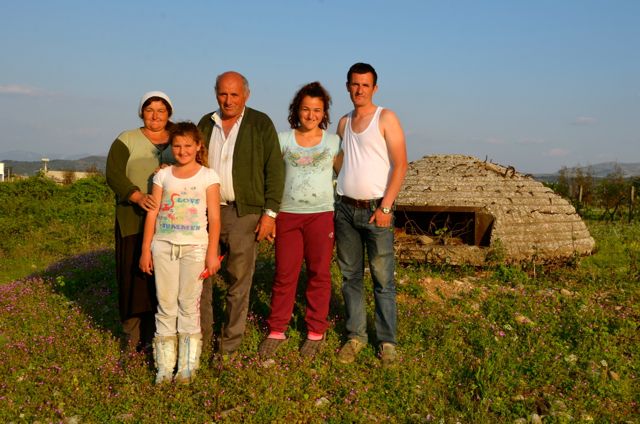
Our Albanian host for the week, 68 year-old, Zef Kodra, estimates that he built 200 of these bunkers. One afternoon, Zef took us out to see one bunker structure that’s just a three-minute walk from his family’s home in the northern Albanian city of Shkoder.
Zef’s bubbly personality is evident as we stroll through his semi-rural neighborhood to ‘his’ bunker. We pass locals who are curious about the foreign visitors he is escorting, and he exudes an air of pride, mentioning the Albanian word ‘bunkari’ multiple times, while gesturing to the field out in the distance where the bunker sits.

On our way, there is a man directing a horse-drawn cart on the concrete road, and another tilling his front yard using a stand-behind horse-drawn plow. The man appears to be riding on a rattan or wooden platform. As we pass the home, the farmer’s wife and young children enthusiastically wave at us, encouraging us to take a photograph of the father. When he rides by us on the plow, he nods and smiles, while ordering the horse to keep pulling. The work looks challenging, not only for the animal, but also for the man.

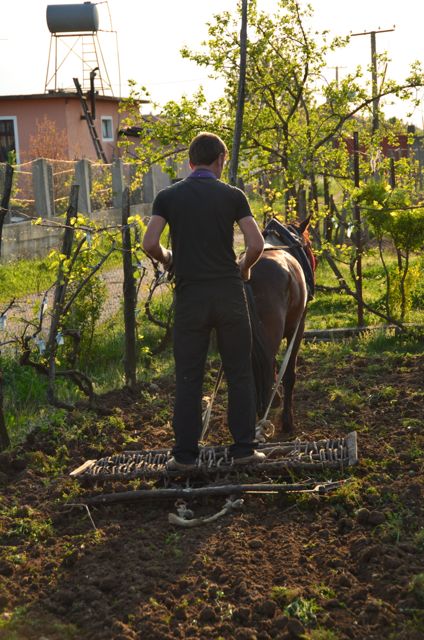


When we reach the bunker, we find that its sniper window is overgrown with a raspberry-like bush. Zef finds a piece of wood, which he uses to tear away the brush. By now, a family of five has emerged from their neighboring home, curious what we’re up to. They smile, giggle, and pose for several pictures in front of the bunker. They ask where we’re from.
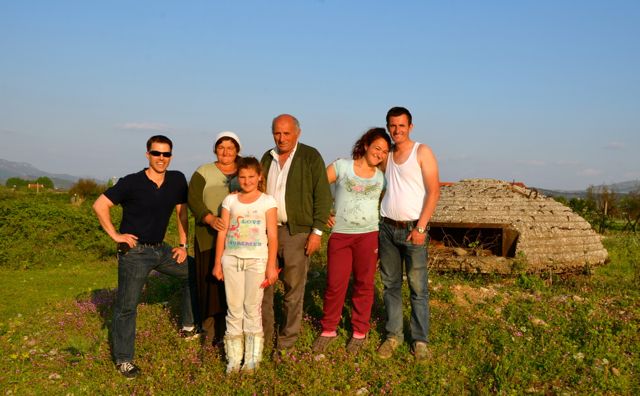

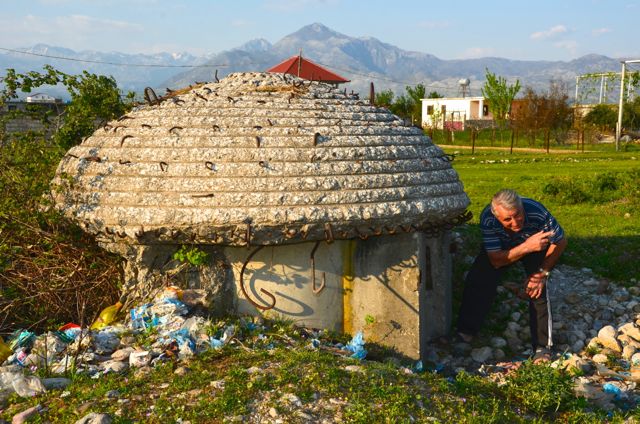
Ever the prankster, Zef climbs inside the bunker, propping the rifle-lookalike piece of wood through the sniper window, pretending to take shots. When he emerges, he makes gestures towards the bunker that suggest that he’s miming a smashing motion with an imaginary sledgehammer.
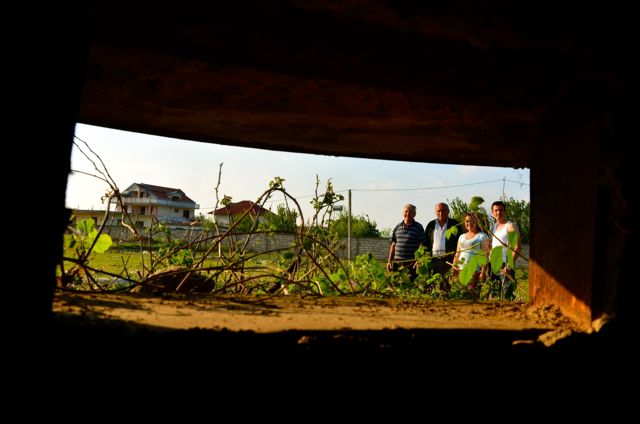
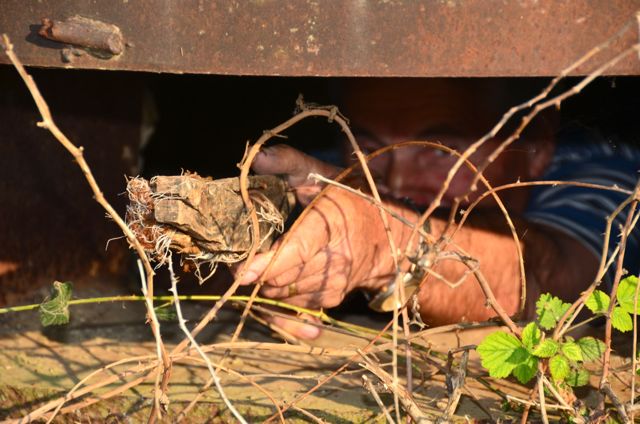


With his son, Florian, acting as translator later that evening, Zef tells us more about his bunker-building years. We sit in the family’s new living room, which they’d just built to expand their guesthouse business. A classic portrait of Zef and his wife, Age, hangs on the wall. In his younger years, Zef resembles the American actor Gregory Peck, I think.
Two times during our interview, the power cuts out. Despite these temporary inconveniences, Zef keeps talking, laughing, and describing his experiences.
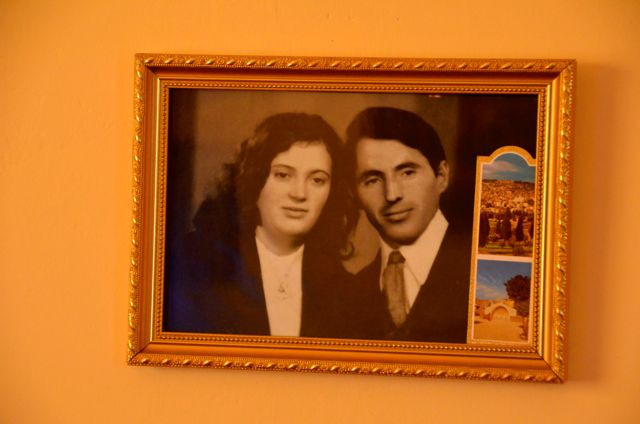
“I built bunkers under the Communist system of Enver Hoxha between 1965-1985,” Zef says. “I once worked on a farm, but one day, the farm’s director told me and the other workers that we must go work in another area. Then we were told to begin building bunkers.”
“It took approximately one week to build one bunker, and there were generally two sizes,” Zef explains. “We used lots of material to build a bunker – there were two types of metal, concrete, and mountain stones. I worked 8-9 hours per day, and earned about €2 per month.”
“The dictator, Enver Hoxha was handsome, but he had a criminial spirit. He put fear into the people of Albania. Albania itself was in jail. We were told that ‘the enemy is coming’ and that ‘we must mobilize, because the Mother Party is calling.’ ”
“The main gangsters were the USA and western Europe. We were ordered not to read American literature because we were told that it would be bad for our health.”
Zef and Florian explained that Albanian citizens needed a passport to visit another Albanian city. International travel was, of course, out of the question. Religion was also banned.
Ironically, one year Hoxha visited a cafeteria in the vicinity of Shkoder, where he sampled the wine that Zef had made himself.

We were curious what Zef thought about all the North American, Western European and Australian guests that frequent his business today, so we asked him if he remembers the first American he ever met. It turns out that he met an Albanian-American immigrant in 1993.
“The government taught us to hate the US, but still we thought America had good freedom and human rights,” Zef says. “Of course, we had to keep our thoughts to ourselves. There was no political dissent.”

Having read recent articles that discussed Albania’s uncertainty about what to do with the plethora of bunkers, we asked Zef his thoughts.
“Destroy them with explosives, collect the scrap metal and sell it. At least then I could get some money for all the work I did to build them,” Zef says.
But Zef does not dwell on the past.
“After a long time of darkness, I am now living the best part of my life. Now, I am in the light.”
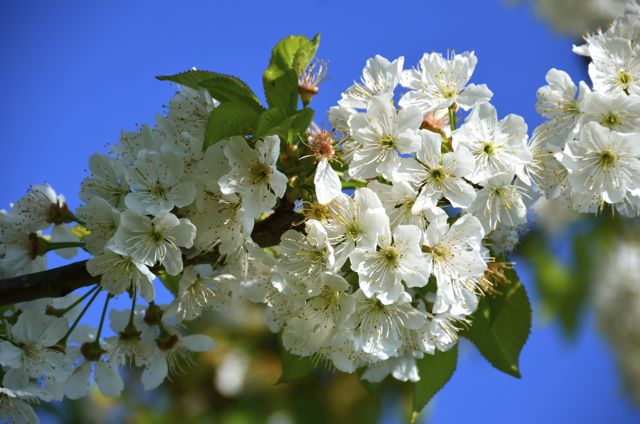
His brother, Tony, who spent several years living in the United States, talks about the period of bunkerization in a more somber fashion.
“So much money was spent on them,” he says. “Houses and roads could’ve been built with those resources.”
Given Albania’s dilapidated roadways and status as one of Europe’s poorest countries, Tony’s assessment is fitting. According to one article, the bunker building undertaking in Albania required “three times as much concrete as was used to build France’s Maginot Line.” Another site claims that it costs approximately €800 to destroy just one bunker.
Florian mentions that some creative Albanians in other cities have turned the bunkers into guesthouses or cafés. We’ve also read that they’ve been repurposed into wine cellars and restaurants. They are also said to shelter animals, the homeless, and young Albanians as they share amorous moments.

The next evening, as we stroll through the family’s vineyard that Zef cultivates, we look upon the spring blooms framed by white-capped mountains, and Albania’s future seems bright.
We’re honored to have met Zef. We’re also happy that he’s had the opportunity to exchange bunker-building for wine-making — and the chance to nurture the family’s ever-growing guesthouse business.
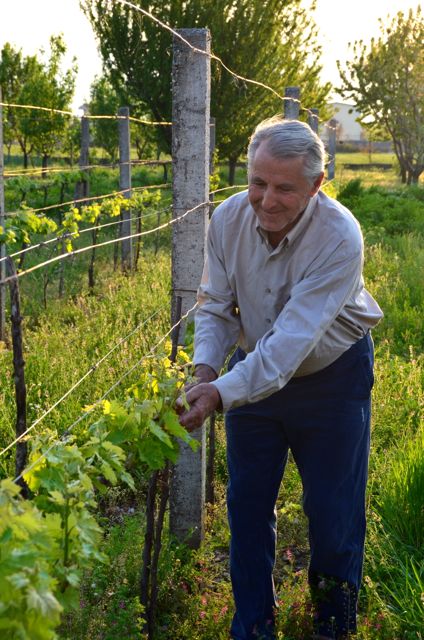
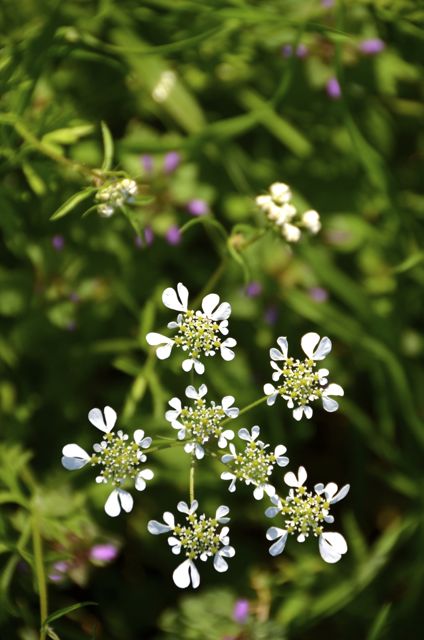
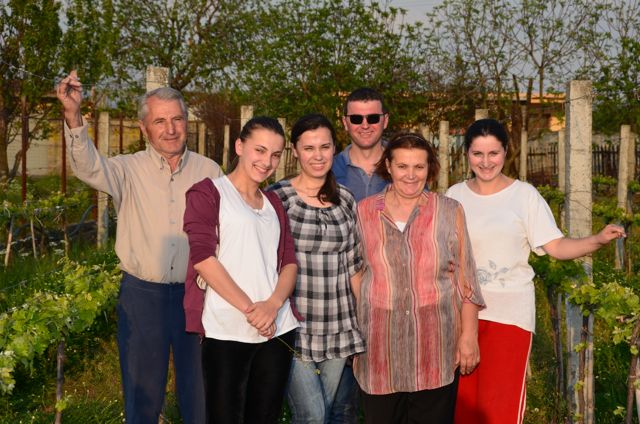
Don’t miss Shawn’s video below, which gives you a better picture of the beautiful Albanian landscape, and the warm reception we received there.
What do you think would be a good use for Albania’s bunkers? Should they be destroyed or repurposed?
Video of this Experience:
Where in the World?
Planning Pointers:
- The city of Shkodër, where Zef and his family live, is located in northwestern Albania, about 110 kilometers (65 miles) from Kotor, Montenegro. We stayed overnight in the town of Ulcinj, Montenegro before crossing the border into Albania. We traveled by bus.
- During our week spent in Shkodër, Shawn and I stayed at Florian’s Guesthouse (affiliate link), an authentic homestay managed by Zef’s son, Florian, and his family. Spending time there allowed us to get a feel for what life is like in a semi-rural, residential Albanian neighborhood. (The homestay is located in the outskirts of Shkodër, about 30 minutes away on foot, but you can borrow a bicycle from the guesthouse to make the journey quicker.) Florian’s mother, Age, and sister, Emanuela, made hearty, traditional meals by scratch, incorporating heaps of fresh vegetables from the family’s garden. The ladies were eager to demonstrate how to make Albanian dishes like Byrek, and Emanuela even made me homemade, gluten-free cornbread, something that paired quite well with the vegetable soup. Father Zef treated us to his homemade wine, lovingly made from grapes grown across the street from the family home. And aunts, uncles, and cousins stopped by, sharing photo albums and wedding tales with us. Fellow guests from the Netherlands, Poland, and England also helped make our stay there enjoyable. As an update from our 2013 visit, we’ve since heard that Florian has opened an additional hostel in Shkodër’s city center.
Photography & text © Tricia A. Mitchell. All Rights Reserved. The video was created by my husband, Shawn.

What and interesting post Tricia! I had no idea. Imagine what life would have been like living in those conditions :-( We are so fortunate, thanks for the reminder.
Tina, I was also surprised to learn of these bunkers just shortly before our visit to Albania. Indeed, we’re fortunate to enjoy our freedoms. While in Albania, we also visited a former Communist jail, where clergy members and political dissidents were imprisoned. Certainly a difficult chapter for the country; here’s hoping they’ll continue to progress!
Cool post.
Happy you enjoyed it, Mark.
Thanks for this fascinating look at Albania, Tricia! I have always been curious about the country. Zef sounds like such a character. I’m always amazed that people who have been subjected to such repressive regimes have such positive outlooks and make the best of their situations. How resourceful to turn the bunkers into cafes and guesthouses.
Would the bunkers work for visitors centers? I suppose that idea would not generate enough income, and it would be expensive to stock them with brochures and literature. Could people, including foreigners, “adopt” or “sponsor” the bunkers and then hire local artists or farmers to beautify them? It could be a national art project perhaps.
Thanks for the post and for educating us! Cheers — Steph
Steph, thanks for your thoughtful comment. I think you’re destined to be a tourism consultant for Albania’s national tourist board. :) I particularly like your idea about people sponsoring the bunkers (sort of like an ‘adopt a highway’ concept) and then dressing them up in an artsy way.
I did learn a few days ago that the bunkers technically belong to the Albanian military, but that if a private property owner has one on their land, they are welcome to use it.
I also heard that some bunkers – on beaches in particular – have proven to be dangerous. Apparently, swimmers have gotten caught in currents around them, so they’ve prioritized destroying bunkers in these spots.
Whoa — bunkers on the beach, too?! I can understand why those would need to be eliminated. By the way, I’d love to be a consultant for the Albanian tourist board! :) Thanks for writing such interesting and informative posts, Tricia. I really enjoy reading them.
I have just added Albania to the list of places that I want to travel to! Beautiful photos and such a descriptive blog. Sounds like you had a fantastic week homestaying with Zef and his family.
Andrea, we certainly had an authentic time in Albania. We contemplated heading to more spots in the country, but we concluded that we probably wouldn’t have any experiences to top what we experienced with the family.
I heard that the Lonely Planet rated Albania as its must-see spot a few years ago, and I can see why. The people are not yet jaded by visitors, and seem to be as curious about visitors, as we are about them. We found that lead to lots of wonderful exchanges. Nice to hear from you again. :)
Reblogged this on kjmhoffman.
Thank you for the share, Jkmhoffman!
What a strange and crazy world we live in Trish. Could this contrast more strongly with highly cultured Dubrovnik? Zef sounds a lovely guy. How do you hold on to your sanity in the face of all that?
Jo, we were happy to see that Zef has such an optimistic view of the present and the future, despite what his country’s been through. The country definitely still bears the scars of once being lead by a tough dictator, but I hope it can continue to grow past them. Its infrastructure, in particular, is challenged. I got a sense that there’s no organized trash pick-up, and we encountered a lot of rugged roads. Still, the people are extremely friendly, welcoming and looking to the future. This was one of the most ‘authentic’ countries we’ve visited in Europe – particularly since tourism is still a young industry there.
I am of Albanian origin and grew up during communist/dictatorship regime in my country. Those ugly bunkers are still there, as to remind us of the madness of certain systems. How did Jews kept their sanity during second WW? We (Albanians) are very optimistic people by nature, We do recognize the value of freedom, I believe a lot more than others in different parts of the world.
Diana, thank you for sharing your thoughtful comment, and for providing a unique insight.
We only spent one week in Albania, however, we did find the people to be very friendly and optimistic as you say. In downtown Shkoder, we were invited into a cafe by its kind owner and then serenaded by a very happy musician. I’ll be sharing that story soon. It’s a travel memory I’ll always cherish.
In which city or region of Albania did you grow up?
Wonderful tale! thank you, v.
Thank you, Vera. Before we got to Albania, we’d read about the bunkers and were eager to see them. Imagine our surprise when we learned that our host had built one that was just around the corner. We lucked out that he was so eager to show it to us too. :)
Good story – I enjoyed it!
Glad you enjoyed it, Andrew. As we rode around the Albanian roads, I heard your comment repeating in the back of my mind (about you not being advised to drive into Albania with your own car). We met an adventurous Dutch couple in Albania that drove as far as Istanbul. Must confess that I was quite comfortable riding a bus and not worrying about having to navigate the challenging roads from behind the wheel. :)
This is fascinating! Zef sounds like quite the host. It’s wonderful that he shared so much insight with you. What a well of knowledge.
I’m not sure what should be done with these bunkers. It’s amazing to think of how many resources were used to build them. I had no idea. But then, we know so little about Albania. I’m glad you’re sharing some its culture and history with us.
Juliann, we were also surprised that we’d never seen mention of these bunkers in the news, before we started researching for our trip. Travel always surprises and teaches!
Tricia, what an interesting post, I learned so much about Albania, thanks for sharing your experiences and adventures, it seems so rich what you see and participate in.
Cornelia, I’m honored that Zef allowed us to tell his stories, and happy that you picked up a few new facts about this corner of the world. :)
Great insightful piece, as always! I always feel like I have actually been on your travels when I read your blog.
Hi Laura, that’s a great compliment; thank you!
On a side note, I can’t get to your site from your profile. Please update so I can catch up on your news from Bavaria. :)
Oh I wonder why that is, I will look into it although I’m not that blog-savvy!
Laura, I think you just update your blog address on your avatar (the little window that pops us when you hover the cursor over your picture). :) How was your trip back home?
thank you, I will do that now! The trip back home was great, but always exhausting with a little one in tow and lots of visits to make. But it felt great to be in England again, but also good to come back to Bavaria. When will you be back this way?
It sounds like Bavaria is becoming your second home, Laura. :) Glad to hear the trip went well. We should be back in O-gau in the next 2 weeks or so. Still looking forward to linking up.
Great! You are coming back at a lovely time, all the flowers are out and I’ve never seen anywhere look so green. Enjoy the next 2 weeks of your travels.
All the rain and snow makes for beautiful flora; I look forward to seeing it abloom soon, Laura! It seems like ages ago since we left O-gau.
Tricia, love this post. Thanks for the intro to Albania and Zeff.
A unique area and definitely a unique person.
Glad you enjoyed it, Maria. The more I travel, the more I realize what I have yet to learn about the world. :)
Albania’s history and these ‘concrete mushrooms’ are one such example!
Thanks for reminding us how lucky we all are!
Charu, it was a pleasure to tell Zef’s story. :) I was touched to hear him say he’s now living the best chapter of his life.
Trish, Thank you for the beautiful inside look.You’re traveling like I hope to be able to do in the near future.
Margaret, pleased to hear that you enjoyed this introduction to Albania! So, what are the first places you are yearning to visit? It’s always nice to hear of others dreaming of seeing the world.
The list is too long! But now that the kids are adults it will be easier! Visiting a sister living in the UK this fall, after that visiting my son in Thailand.
Margaret, it’s wonderful to have friends and family at a distance to visit. In which part of Thailand does your son live? I’m dreaming of the ample supply of fresh mango and pineapple now. :)
Tricia, That’s amazing! I’d never even heard of Albania’s “bunkerization program.” Thank you for the wonderful look inside everyday life in a fascinating country. ~Terri
Terri, up until we did a bit of research pre-Albania, we hadn’t either. Perhaps now that you’ve finished renovating Basecamp Gallivance, you could repurpose an Albanian bunker? I hear they make great wine cellars, restaurants and little hostels… :)
Thank you very much for sharing this experience. I live close in Albania (Greece) and met Albanian friends. I heard from them how beautiful their country and it was abused by a dictator. And reading this beautiful and touching story, is another eye-opener to me. Really love your blog! Best wishes to you both. :)
Nessy, thank you for stopping by and for sharing the anecdote about your Albanian friends. I hope that their country will continue to grow and prosper, following such a difficult chapter.
We’re considering visiting Meteora for a few days. Actually, we’d love to stay in Greece for a few months, but cannot right now. In which part of the country do you live? I’ve only been to Athens, but am eager to see the islands and more of the mainland!
This is a very interesting post Tricia. I’ve never been there, though I have been close, at not much than a mile away at Agios Stephanos on Corfu many times. I understand that in the old days, Albanians used to swim across to escape the regime.
The bunkers are part of the history. I expect that finding new uses will be the way forward for the immediate future, but I guess that they will one day be removed to allow development.
David, I’ve heard that Corfu is a beautiful place! We thought about heading there while we were visiting Albania, but instead diverted to Macedonia. It’s sometimes hard to believe that living conditions can be so different – just across manmade borders and natural ones. I hope that Albania will continue to grow and develop after such a difficult chapter.
How has your spring/summer been? I hear that the weather’s been a bit unseasonal in parts of Europe. Here’s hoping sunny skies are en route.
The sun has at last come out Tricia. Spring was more than a little late this year. It has been cold and wet up to a few weeks ago. Just as we are off to find the sun, it has come out here. That’s par for the course for us!
The first time we went to Corfu was many years ago (about 22), and some areas were becoming very commercialised, even then. In fact, that was the first time we had been on holiday abroad since a couple of camping trips in France with very young children. It is, however, still possible to find some really pretty parts of the island. Just stay away from the ‘clubbing’ resorts.
Dave, your description of Corfu’s more off-the-beaten-path locales have me yearning to return to Greece! As for summer, I hope it’s continuing in your part of the world, or, were you on holiday? We just returned from France, where it was unusually chilly/rainy/grey. Those were the kind of days during which we had to make our own sunshine. :)
Tricia, to be fair to the English climate, we did have some good weather just before we went to Spain for a week, but it feels cold now we are back.
Hello Tricia,
I just chanced upon your blog and found it irresistible :)
Beautifully organized pages with great stories and images from across the world.
Let me explore…
Sreejith, such kind words; I appreciate the feedback.
I hope you enjoy the tales!
Wow, I loved this. It’s so easy to forget how different life is for citizens across the EU. For me, the communist past seems so long ago, it’s good to be reminded that for some families it feels very recent.
Having grown up in a large country (the United States), I find Europe’s more ‘compact diversity’ fascinating. Ultimately traveling overland from Germany all the way to Albania (by bus!), I enjoyed contrasting the architecture, and seeing how the food and modes of transport changed. And you’re right about feeling the legacy of communism in parts of Albania. Fortunately, isolation is not an issue there like it was during the Hoxha era, and people like Zef and Florian can move in a direction they want. It’s heartwarming to see what this family has accomplished. Thanks for taking the time to visit and share your thoughts, afarawayhome. Wish you happy travels!